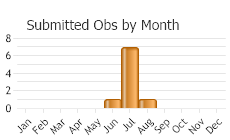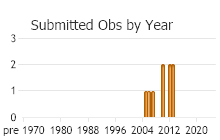View in other NatureServe Network Field Guides
NatureServe
Montana
Utah
Wyoming
Idaho
Wisconsin
British Columbia
South Carolina
Yukon
California
New York
Mariposa Copper - Tharsalea mariposa
Native Species
Global Rank:
G5
State Rank:
S5
Agency Status
USFWS:
USFS:
BLM:
External Links
General Description
[From Ferris and Brown 1981; Scott 1986; Opler and Wright 1999; Glassberg 2001; Pyle 2002] Forewing 1.3-1.7 cm. Fringes of wings black and white checked. Uppersurface of male iridescent dark purple, female brown with yellow patches on forewing; undersurface of hindwing mottled gray with black dots and dashes and submarginal band of inwardly-pointing black chevrons, forwing orange-flushed with heavy black marks.
Phenology
One flight; mid-July to August (Scott 1986). Late June to August (Glassberg 2001). Mid-July through August in Rocky Mountain states (Ferris and Brown 1981), late May to late September in Oregon and Washington (Pyle 2002), late June through August in Oregon (Warren 2005), late June to early September in British Columbia (Threatful 1988; Guppy and Shepard 2001).
Diagnostic Characteristics
Best determined by a combination of the fringes of wings black and white checked; undersurface of hindwing mottled gray with black dots and dashes and submarginal band of inwardly-pointing black chevrons, forewing orange-flushed with heavy black marks.
Species Range
Montana Range
Range Descriptions

 Native
Native
Range Comments
Southeastern Alaska and Yukon south to central California, Idaho, and western Wyoming; isolated population in the Cypress Hills of Alberta/Saskatchewan (Scott 1986; Opler and Wright 1999; Glassberg 2001). Mostly above 2500 m elevation in Rocky Mountain region (Ferris and Brown 1981), 914 m to 2316 m elevation in Oregon (Warren 2005), 488 m to 1463 m elevation in southeastern British Columbia (Threatful 1988). In Montana, reported from the montane western half of the state (Kohler 1980; Stanford and Opler 1993). Common to abundant, except rare to uncommon in California Sierra Nevada (Glassberg 2001).
Observations in Montana Natural Heritage Program Database
Number of Observations: 29
(Click on the following maps and charts to see full sized version)
Map Help and Descriptions
Relative Density

Recency



 (Observations spanning multiple months or years are excluded from time charts)
(Observations spanning multiple months or years are excluded from time charts)
Migration
Non-migratory.
Habitat
Moist meadows and openings in lodgepole pine forest, coniferous forest, bogs, roadsides, trail sides, dry slopes and summits (Ferris and Brown 1981; Scott 1986; Opler and Wright 1999; Pyle 2002). In Glacier National Park, Montana reported from xeric montane meadows (Debinski 1993).
National Vegetation Classification System Groups Associated with this Species
Forest and Woodland
Deciduous Forest and Woodland
Montane - Subalpine Forest and Woodland
Grassland
Montane - Subalpine Grassland
Wetland and Riparian
Alkaline - Saline Wetlands
Alpine Riparian and Wetland
Peatland
Riparian and Wetland Forest
Riparian Shrubland
Wet Meadow and Marsh
Food Habits
Larval food plants include Andromeda and at least four species of Vaccinium (Scott 1986; Guppy and Shepard 2001; Warren 2005; James and Nunnalee 2011). Adults feed on flower nectar, including Achillea, Anaphalis, Gentiana, Leucanthemum, Sanguisorba, Sedum, Senecio, Spiraea, and Symphyotrichum (Pyle 2002; James and Nunnallee 2011; Scott 2014).
Reproductive Characteristics
Females lay eggs on host plant stems or leaves near plant base; eggs overwinter. Eggs hatch after about about 3-6 days of development. Larvae develop from L1 instar to L4 instar and pupation in about 23-31 days after egg-hatch. Larvae feed on flower buds, small fruits, but mostly leaves. Adults eclose (emerge from pupae) in about 17 days (depending on temperature). Larvae do not construct nests, are sometimes attended by ants (Scott 1979; James and Nunnallee 2011). Males perch throughout the day on low trees and shrubs in depressions and valley bottoms in dense forest clearings awaiting passing females, sometimes patrol around flowers (Scott 1975b, 1986; Warren 2005).
Stewardship Responsibility
References
- Literature Cited AboveLegend:
 View Online Publication
View Online Publication Debinski, D. 1993. Butterflies of Glacier National Park, Montana. Occasional Papers of the Museum of Natural History, the University of Kansas, Lawrence, Kansas. No. 159: 1-13.
Debinski, D. 1993. Butterflies of Glacier National Park, Montana. Occasional Papers of the Museum of Natural History, the University of Kansas, Lawrence, Kansas. No. 159: 1-13. Ferris, C.D. and F.M. Brown (eds). 1981. Butterflies of the Rocky Mountains. Univ. of Oklahoma Press. Norman. 442 pp.
Ferris, C.D. and F.M. Brown (eds). 1981. Butterflies of the Rocky Mountains. Univ. of Oklahoma Press. Norman. 442 pp. Glassberg, J. 2001. Butterflies through Binoculars: A Field Guide to the Butterflies of Western North America. Oxford University Press.
Glassberg, J. 2001. Butterflies through Binoculars: A Field Guide to the Butterflies of Western North America. Oxford University Press. Guppy, C.S. and J.H. Shepard. 2001. Butterflies of British Columbia: including western Alberta, southern Yukon, the Alaska Panhandle, Washington, northern Oregon, northern Idaho, northwestern Montana. UBC Press (Vancouver, BC) and Royal British Columbia Museum (Victoria, BC). 414 pp.
Guppy, C.S. and J.H. Shepard. 2001. Butterflies of British Columbia: including western Alberta, southern Yukon, the Alaska Panhandle, Washington, northern Oregon, northern Idaho, northwestern Montana. UBC Press (Vancouver, BC) and Royal British Columbia Museum (Victoria, BC). 414 pp. James, D.G. and D. Nunnallee. 2011. Life histories of Cascadia butterflies. Corvallis, OR: Oregon State University Press. 447 p.
James, D.G. and D. Nunnallee. 2011. Life histories of Cascadia butterflies. Corvallis, OR: Oregon State University Press. 447 p. Kohler, S. 1980. Checklist of Montana Butterflies (Rhopalocera). Journal of the Lepidopterists' Society 34(1): 1-19.
Kohler, S. 1980. Checklist of Montana Butterflies (Rhopalocera). Journal of the Lepidopterists' Society 34(1): 1-19. Opler, P.A. and A.B. Wright. 1999. A field guide to western butterflies. Second edition. Peterson Field Guides. Houghton Mifflin Company, Boston, Massachusetts. 540 pp.
Opler, P.A. and A.B. Wright. 1999. A field guide to western butterflies. Second edition. Peterson Field Guides. Houghton Mifflin Company, Boston, Massachusetts. 540 pp. Pyle, R.M. 2002. The butterflies of Cascadia: a field guide to all the species of Washington, Oregon, and surrounding territories. Seattle Audubon Society, Seattle, Washington. 420 pp.
Pyle, R.M. 2002. The butterflies of Cascadia: a field guide to all the species of Washington, Oregon, and surrounding territories. Seattle Audubon Society, Seattle, Washington. 420 pp. Scott, J.A. 1975b. Mate-locating behavior of western North American butterflies. Journal of Research on the Lepidoptera 14:1-40.
Scott, J.A. 1975b. Mate-locating behavior of western North American butterflies. Journal of Research on the Lepidoptera 14:1-40. Scott, J.A. 1979. Hibernal diapause of North American Papilionoidea and Hesperioidea. Journal of Research on the Lepidoptera 18(3): 171-200.
Scott, J.A. 1979. Hibernal diapause of North American Papilionoidea and Hesperioidea. Journal of Research on the Lepidoptera 18(3): 171-200. Scott, J.A. 1986. The butterflies of North America: a natural history and field guide. Stanford University Press, Stanford, California.
Scott, J.A. 1986. The butterflies of North America: a natural history and field guide. Stanford University Press, Stanford, California. Scott, J.A. 2014. Lepidoptera of North America 13. Flower visitation by Colorado butterflies (40,615 records) with a review of the literature on pollination of Colorado plants and butterfly attraction (Lepidoptera: Hersperioidea and Papilionoidea). Contributions of the C.P. Gillette Museum of Arthopod Diversity. Fort Collins, CO: Colorado State University. 190 p.
Scott, J.A. 2014. Lepidoptera of North America 13. Flower visitation by Colorado butterflies (40,615 records) with a review of the literature on pollination of Colorado plants and butterfly attraction (Lepidoptera: Hersperioidea and Papilionoidea). Contributions of the C.P. Gillette Museum of Arthopod Diversity. Fort Collins, CO: Colorado State University. 190 p. Stanford, R.E. and P.A. Opler. 1993. Atlas of western USA butterflies: including adjacent parts of Canada and Mexico. Unpubl. Report. Denver and Fort Collins, Colorado 275 pp.
Stanford, R.E. and P.A. Opler. 1993. Atlas of western USA butterflies: including adjacent parts of Canada and Mexico. Unpubl. Report. Denver and Fort Collins, Colorado 275 pp. Threatful, D.L. 1988. A list of the butterflies and skippers of Mount Revelstoke and Glacier National Parks, British Columbia, Canada (Lepidoptera). Journal of Research on the Lepidoptera 27(3-4): 213-221.
Threatful, D.L. 1988. A list of the butterflies and skippers of Mount Revelstoke and Glacier National Parks, British Columbia, Canada (Lepidoptera). Journal of Research on the Lepidoptera 27(3-4): 213-221. Warren, A.D. 2005. Lepidoptera of North America 6: Butterflies of Oregon, their taxonomy, distribution, and biology. Contributions of the C. P. Gillette Museum of Arthropod Diversity, Colorado State University. Fort Collins, Colorado. 406 pp.
Warren, A.D. 2005. Lepidoptera of North America 6: Butterflies of Oregon, their taxonomy, distribution, and biology. Contributions of the C. P. Gillette Museum of Arthropod Diversity, Colorado State University. Fort Collins, Colorado. 406 pp.
- Additional ReferencesLegend:
 View Online Publication
View Online Publication
Do you know of a citation we're missing? Allen, T.J., J.P. Brock, and J. Glassberg. 2005. Caterpillars in the field and garden: a field guide to the butterfly caterpillars of North America. Oxford University Press.
Allen, T.J., J.P. Brock, and J. Glassberg. 2005. Caterpillars in the field and garden: a field guide to the butterfly caterpillars of North America. Oxford University Press. Brock, J.P. and K. Kaufman. 2003. Kaufman Field Guide to Butterflies of North America. Houghton Mifflin Company, New York, NY 284 pp.
Brock, J.P. and K. Kaufman. 2003. Kaufman Field Guide to Butterflies of North America. Houghton Mifflin Company, New York, NY 284 pp. Caruthers, J.C., and D. Debinski. 2006. Montane meadow butterfly species distributions in the Greater Yellowstone Ecosystem. University of Wyoming National Park Service Research Center Annual Report, 2006. Vol. 30, Art. 14. 85-96.
Caruthers, J.C., and D. Debinski. 2006. Montane meadow butterfly species distributions in the Greater Yellowstone Ecosystem. University of Wyoming National Park Service Research Center Annual Report, 2006. Vol. 30, Art. 14. 85-96. Debinski, D. M. 1991. Inventory and monitoring of biodiversity: an assessment of methods and a case study of Glacier National Park, MT. Ph.D. Dissertation. Montana State University, Bozeman. 205 p.
Debinski, D. M. 1991. Inventory and monitoring of biodiversity: an assessment of methods and a case study of Glacier National Park, MT. Ph.D. Dissertation. Montana State University, Bozeman. 205 p. Forister, M.L., C.A. Halsch, C.C. Nice, J.A. Fordyce, T.E. Dilts, J.C. Oliver, K.L. Prudic, A.M. Shapiro, J.K. Wilson, J. Glassberg. 2021. Fewer butterflies seen by community scientists across the warming and drying landscapes of the American West. Science 371:1042-1045.
Forister, M.L., C.A. Halsch, C.C. Nice, J.A. Fordyce, T.E. Dilts, J.C. Oliver, K.L. Prudic, A.M. Shapiro, J.K. Wilson, J. Glassberg. 2021. Fewer butterflies seen by community scientists across the warming and drying landscapes of the American West. Science 371:1042-1045. Forister, M.L., E.M. Grames, C.A. Halsch, K.J. Burls, C.F. Carroll, K.L. Bell, J.P. Jahner, et al. 2023. Assessing risk for butterflies in the context of climate change, demographic uncertainty, and heterogeneous data sources. Ecological Monographs 93(3):e1584. https://doi.org/10.1002/ecm.1584
Forister, M.L., E.M. Grames, C.A. Halsch, K.J. Burls, C.F. Carroll, K.L. Bell, J.P. Jahner, et al. 2023. Assessing risk for butterflies in the context of climate change, demographic uncertainty, and heterogeneous data sources. Ecological Monographs 93(3):e1584. https://doi.org/10.1002/ecm.1584 Fultz, J.E. 2005. Effects of shelterwood management on flower-visiting insects and their floral resources. M.Sc. Thesis. Bozeman, MT: Montana State University. 163 p.
Fultz, J.E. 2005. Effects of shelterwood management on flower-visiting insects and their floral resources. M.Sc. Thesis. Bozeman, MT: Montana State University. 163 p. Layberry, R.A., P.W. Hall, and J.D. LaFontaine. 1998. The Butterflies of Canada. University of Toronto Press. 280 pp. + color plates.
Layberry, R.A., P.W. Hall, and J.D. LaFontaine. 1998. The Butterflies of Canada. University of Toronto Press. 280 pp. + color plates. Maxell, B.A. 2016. Northern Goshawk surveys on the Beartooth, Ashland, and Sioux Districts of the Custer-Gallatin National Forest: 2012-2014. Montana Natural Heritage Program. Helena, MT. 114pp.
Maxell, B.A. 2016. Northern Goshawk surveys on the Beartooth, Ashland, and Sioux Districts of the Custer-Gallatin National Forest: 2012-2014. Montana Natural Heritage Program. Helena, MT. 114pp.
- Web Search Engines for Articles on "Mariposa Copper"
- Additional Sources of Information Related to "Insects"





